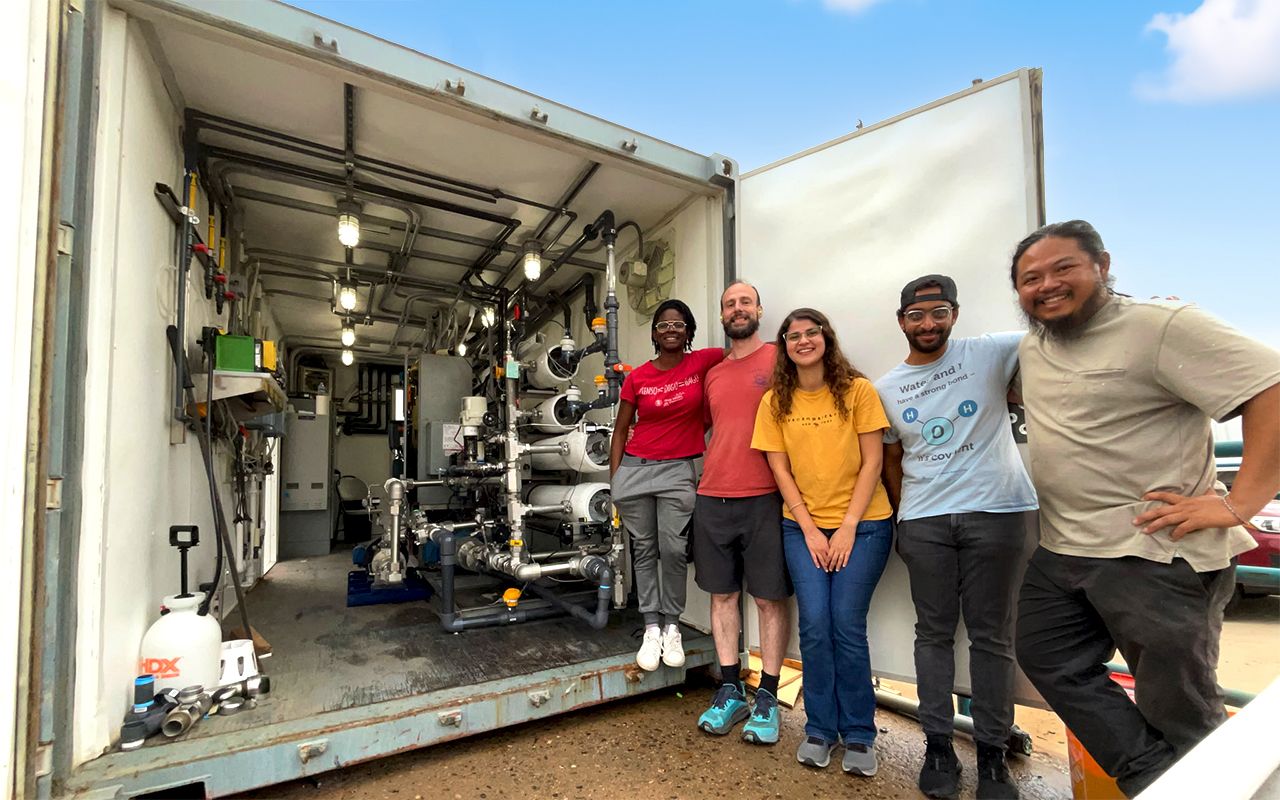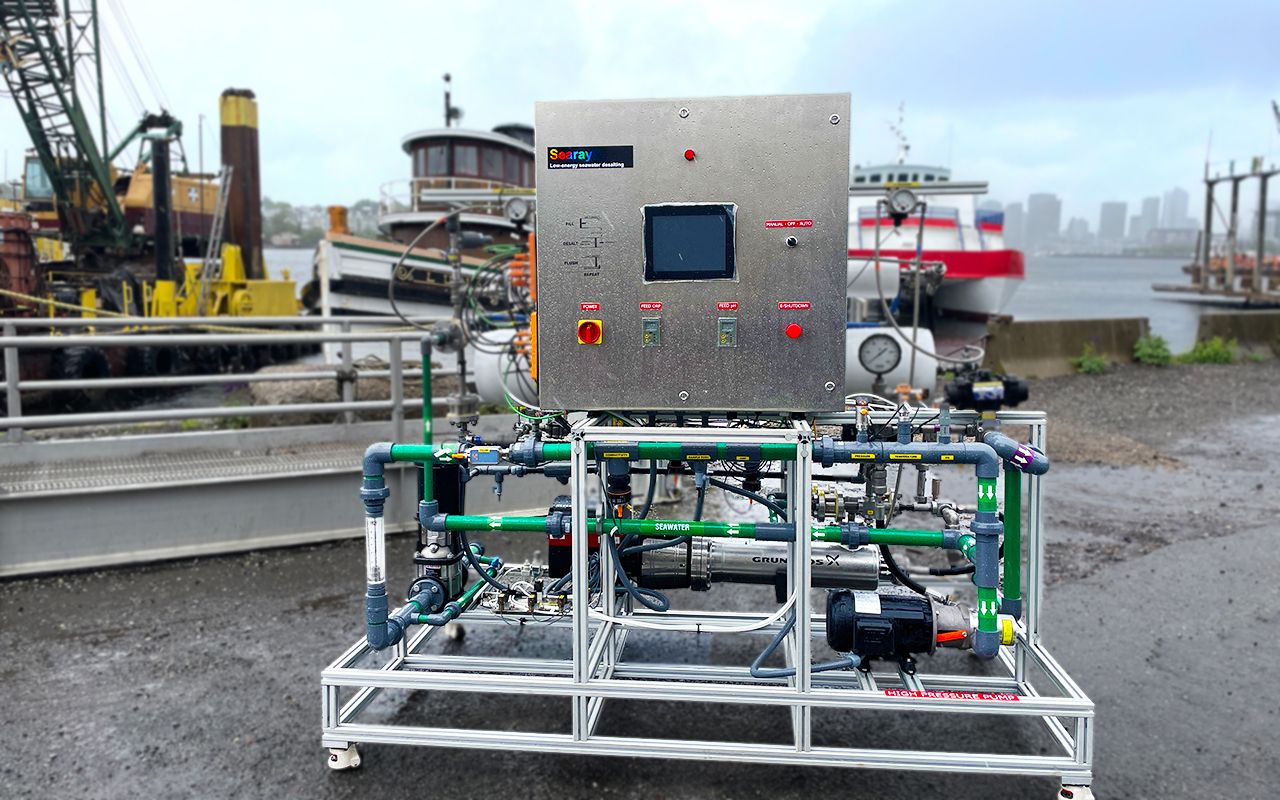This press release was also published to PRWeb
August 7, 2025
Harmony Desalting’s 2025 Pilots Are Bigger and Better Than Ever
Harmony Desalting’s water treatment pilots, Chimaera and Searay, demonstrate the advantages of their patented Batch Reverse Osmosis technology are replicable at larger scales and higher pressures
BOSTON, MA — The summer of 2025 has been a period of evolution for Harmony Desalting, a Boston-based desalination start-up. Over the past three years, Harmony has been developing the best way to deliver cheaper and more efficient desalination to the world: batch reverse osmosis. During the first half of 2025 the team built, commissioned and delivered Searay, its first seawater desalting unit. July opened with the commissioning of Chimaera, the company’s largest pilot yet. Most recently, the Texas Water Development Board announced a $200,000 grant to Plum Creek Conservation District (Lockhart, TX) for enhancing freshwater supply for agriculture — using Harmony’s innovative desalting technology.

Inland desalination that produces more freshwater, less brine
In July the Harmony team flew to the WE2ST Water Technology Hub (Denver, CO) to commission Chimaera, a hybrid RO system capable of operating and comparing five different RO processes, including Harmony’s bladder-based batch process. The study is funded by the National Alliance for Water Innovation (NAWI) with additional funds from the Department of Defense.
Inland desalination units must operate at higher water recovery rates to reduce the costs of brine management. Harmony’s batch process can exceed the water recovery limits of standard RO by regularly rinsing the membrane between each production cycle. As a result, brine volumes are reduced by 50-90%.
NAWI is excited by the rapid technical progress the team has made in Colorado. They piloted several important innovations to improve Batch RO as a process and gathered critical data to demonstrate its cost and energy efficiency. We are excited to see that Batch RO is particularly well-suited for reaching the highest water recovery and brine minimization.
—Dr. Peter Fiske, Executive Director of the National Alliance for Water Innovation

Seawater desalination at the highest energy efficiency
Earlier in the summer, the team at Harmony Desalting visited Singapore to deliver their first seawater desalting pilot, Baby Searay. Due to the high salinity of seawater (35,000 ppm) this system was built to operate at higher pressures: up to 83 bar (1200 psi). By operating at variable salinities and pressures, Baby Searay can reduce energy demand by 30% or more compared to standard RO processes.
Bigger systems and higher pressures
Chimaera is the first of Harmony’s pilots to operate multiple membrane and bladder modules in parallel, a critical step towards scale-up of the desalting process. Along with Chimaera’s increased production (200 m3/day), Baby Searay’s higher pressures are part of the plan to move Harmony Desalting from the pilot phase into the commercial stage.
Over the past couple months, we’ve achieved two key technical milestones: operating at higher pressures than before and scaling up to our largest production capacity yet. We’re now confident to take the next step towards full-scale deployment: commissioning a 1,000 m3/day ‘train’, the basic building block of a large brackish or seawater desalination plant.
— Dr. Quantum Wei, Founder & CEO of Harmony Desalting
Providing Texas farmers with new freshwater sources for irrigation
Harmony is also deploying the batch desalting technology to farms in Texas. A recently awarded 2026 project is part of Plum Creek Conservation District’s initiative to increase water supply for irrigation by desalinating groundwater at a 90% recovery rate. Texas is one of the largest agricultural regions in the United States and its population is growing quickly.
About 15 years ago I incorrectly classified a Plum Creek Conservation District area within the Saline Edwards Aquifer as a ‘No Groundwater Zone’ And I told those seeking to drill a well that there was no water there. But oh, how has my perception changed! I now call these areas ‘Potential Desal Zones.’ And perhaps in another 15 years due to the research that Harmony is conducting they will be called ‘Groundwater Production Zones’
— Dan Meyer, Executive Director of Plum Creek Conservation District
Because of the rising gap between freshwater supply and demand, the Texas Water Development Board (TWDB) seeks to provide new and cheaper water sources for farmers while protecting existing freshwater sources. Through its Agricultural Water Conservation Grants Program, the TWDB has granted $200,000 to Plum Creek for “Advancing Agricultural Resilience through Cost Effective Ground Water Treatment in South Central TX.” Plum Creek is contributing an additional $200,000 as cost-share for the project, which will deploy Harmony’s batch desalting technology.
Trailer
About
About the WE2ST Water Technology Hub @ Colorado School of Mines
Colorado School of Mines started the WE2ST Water Technology Hub (Water Hub) to promote academic-industry collaboration to solve municipal and industrial water problems across scales. The Water Hub is based out of a 10,000 sq. ft. R&D facility with high-bay labs, analytical/wet labs, and office space.
About the National Alliance for Water Innovation (NAWI)
NAWI is a research program and public-private partnership supported by the United States Department of Energy (DOE) in partnership with the California Department of Water Resources and the California State Water Resources Control Board. NAWI brings together a world-class team of industry and academic partners to examine the critical technical barriers and research needed to radically lower the cost and energy of desalination and water reuse.
About Plum Creek Conservation District
Plum Creek Conservation District was formed in 1957 by the Texas Legislature through the enactment of SB 289 for the purpose of flood control. On January 1st, 1989, Plum Creek Conservation District’s enabling legislation was amended to add groundwater responsibilities that was affirmed by District voters on May 1st, 1993. Groundwater responsibilities involve the regulation of multiple aquifers in the District to provide for the conservation, preservation, protection, recharging, and prevention of waste of groundwater.
About the Texas Water Development Board
The mission of the Texas Water Development Board (TWDB) is to lead the state’s efforts in ensuring a secure water future for Texas. Since 1957, the TWDB has been charged with addressing the state’s water needs. The TWDB works to ensure Texans have access to sufficient, clean, and affordable water supplies that foster a healthy economy and environment.
About Harmony Desalting
Harmony Desalting is a water treatment company with the mission to make desalination more affordable and sustainable through their patented batch reverse osmosis process. Since spinning out of MIT in 2021, the company has won competitions (US Reclamation’s More Water Less Concentrate Challenge, Canada’s IDEaS Pop Up City Contest) and received an Impact Medal in the inaugural Global Prize in Desalination. The company is currently deploying pilots around the globe and demonstrating their versatility by treating water for irrigation, human consumption, and industrial use.
Contact
Quantum Wei, PhD
Founder & CEO, Harmony Desalting
quantum@harmonydesalting.com
Ph: +1 (703) 371-1677


